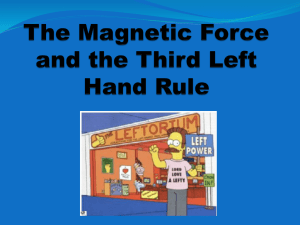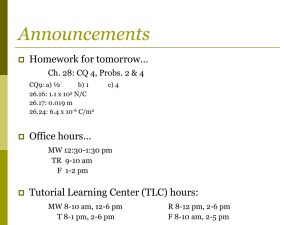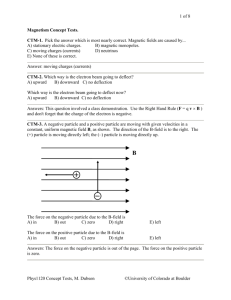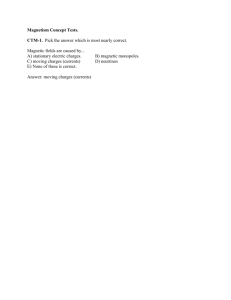BfieldCTa
advertisement
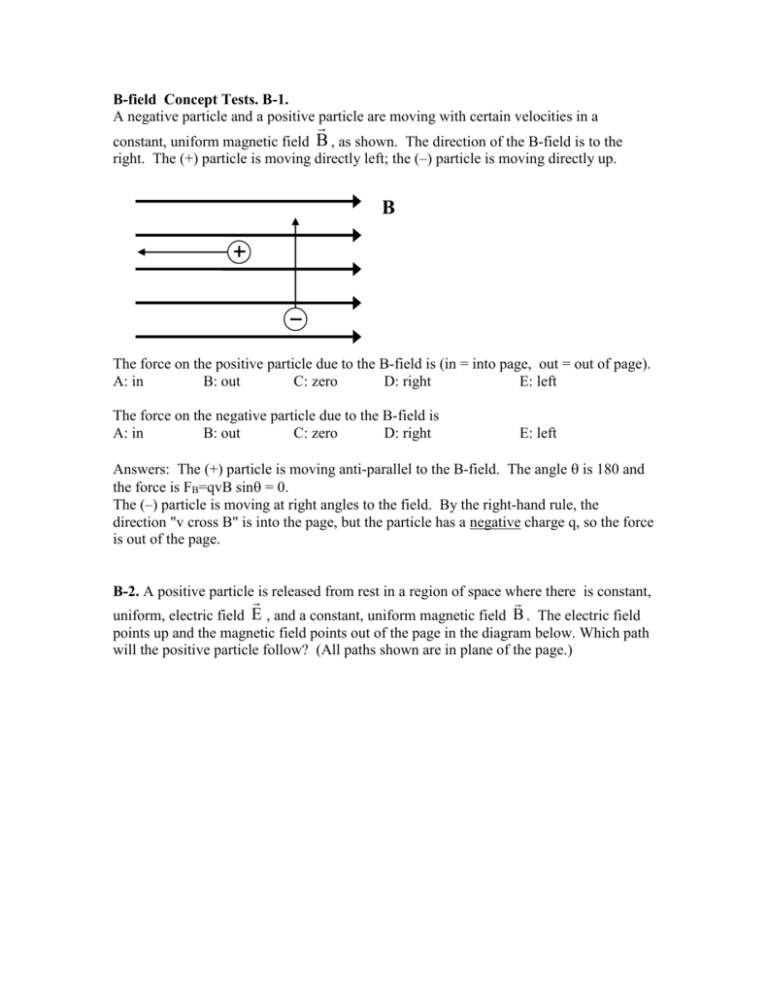
B-field Concept Tests. B-1. A negative particle and a positive particle are moving with certain velocities in a constant, uniform magnetic field B , as shown. The direction of the B-field is to the right. The (+) particle is moving directly left; the (–) particle is moving directly up. B The force on the positive particle due to the B-field is (in = into page, out = out of page). A: in B: out C: zero D: right E: left The force on the negative particle due to the B-field is A: in B: out C: zero D: right E: left Answers: The (+) particle is moving anti-parallel to the B-field. The angle is 180 and the force is FB=qvB sin = 0. The (–) particle is moving at right angles to the field. By the right-hand rule, the direction "v cross B" is into the page, but the particle has a negative charge q, so the force is out of the page. B-2. A positive particle is released from rest in a region of space where there is constant, uniform, electric field E , and a constant, uniform magnetic field B . The electric field points up and the magnetic field points out of the page in the diagram below. Which path will the positive particle follow? (All paths shown are in plane of the page.) A E B C B(out) D: it will remain stationary Answer: The (+) particle will feel a force FE = qE due to the E-field along the direction of the E-field. As it starts moving along the E-field direction, it will acquire a velocity, and it will start to feel a force FB=qvB, due to the B-field. The direction of the force is to the right, by the right-hand-rule. B-3. A (+) charged particle with an initial speed vo is moving in a plane perpendicular to a uniform magnetic field (B into the page). There is a tenuous gas throughout the region which causes viscous drag and slows the particle over time. The path of the particle is A: a spiral inward B: a spiral outward B C: something else If the time for the particle to complete the first revolution (once around) is 1 second, the time for the first 5 revolutions is A: > 5 s B: < 5 s C: 5 s Answers: It will spiral in. As the particle's speed v decreases, its orbital radius decreases according to R = (mv)/(qB). The period is 5s. The period T and the frequency f = 1/T are independent of the radius R or the speed v. The "cyclotron frequency" is f = (qB)/2m. As the speed v decreases, the radius R decreases in proportional. It moves more slowly, but around a smaller circle, so the time to go around once remains constant. B-4. A square loop of wire carrying current I is in a uniform magnetic field B. The loop is perpendicular to B (B out of the page). What is the direction of the net force on the wire? A: out of the page B: into the page B C: D: E: None of these I The same loop is now in a non-uniform field. B Bz , where B = B(y) = A y , where A is a constant. The direction of the net force is ... B stronger B A C B weaker D E: net force is zero Answers: When the B-field is uniform, the net force is zero. The force on each side is F = I L B, where L is the edge length. The forces on each edge each point away from the square and so they cancel. In the non-uniform B-field, the net force is upward, since the upward force on the top wire is larger than the downward force on the bottom wire. B-5. A particle with unknown charge (but non-zero) q and moving left with speed v enters a regions where there is a uniform electric field down and a uniform magnetic field out of the page. The particle is observed to go in a straight line. The charge of the particle must be ... A: positive B: negative C: impossible to determine. B Suppose the particle is a proton. If the speed of the proton is increased, it will A: still undergo no deflection B: deflect out of the plane of the page v C: stay in the plane of the page and deflect upward D: stay in the plane of the page and deflect downward E Answers: Impossible to tell the sign of the charge. It is possible that the charge could be either positive or negative. If the charge is positive the force from the E-field is down, the force from the B-field is up, and the forces cancel. But if charge is negative, both forces switch direction and the forces still cancel. In either case, the fact that the particles is moving with constant velocity implies that Fnet = 0. Since the net force is zero, the magnetic force (magnitude |q|vB) must cancel the electric force (magnitude |q|E). So we have vB = E (the |q|’s cancel), so only particles with speed v = E/B pass straight thru, regardless of the sign or magnitude of the charge. This device is called a velocity selector: only particle with this speed go straight thru; any other speed will result in a curving trajectory. FE = qE FB = qvB v B v + FB = qvB E FE = qE As the speed of the proton increases, its trajectory stays in the plane of the page and deflects upward. If the speed v is increased, the (upward) magnetic force FB = qvB is increased , but the downward electric-field force FE = qE remains the same.
